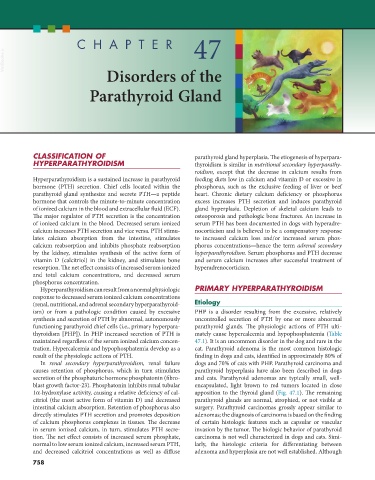Page 786 - Small Animal Internal Medicine, 6th Edition
P. 786
758 PART VI Endocrine Disorders
CHAPTER 47
VetBooks.ir
Disorders of the
Parathyroid Gland
CLASSIFICATION OF parathyroid gland hyperplasia. The etiogenesis of hyperpara-
HYPERPARATHYROIDISM thyroidism is similar in nutritional secondary hyperparathy-
roidism, except that the decrease in calcium results from
Hyperparathyroidism is a sustained increase in parathyroid feeding diets low in calcium and vitamin D or excessive in
hormone (PTH) secretion. Chief cells located within the phosphorus, such as the exclusive feeding of liver or beef
parathyroid gland synthesize and secrete PTH—a peptide heart. Chronic dietary calcium deficiency or phosphorus
hormone that controls the minute-to-minute concentration excess increases PTH secretion and induces parathyroid
of ionized calcium in the blood and extracellular fluid (ECF). gland hyperplasia. Depletion of skeletal calcium leads to
The major regulator of PTH secretion is the concentration osteoporosis and pathologic bone fractures. An increase in
of ionized calcium in the blood. Decreased serum ionized serum PTH has been documented in dogs with hyperadre-
calcium increases PTH secretion and vice versa. PTH stimu- nocorticism and is believed to be a compensatory response
lates calcium absorption from the intestine, stimulates to increased calcium loss and/or increased serum phos-
calcium reabsorption and inhibits phosphate reabsorption phorus concentrations—hence the term adrenal secondary
by the kidney, stimulates synthesis of the active form of hyperparathyroidism. Serum phosphorus and PTH decrease
vitamin D (calcitriol) in the kidney, and stimulates bone and serum calcium increases after successful treatment of
resorption. The net effect consists of increased serum ionized hyperadrenocorticism.
and total calcium concentrations, and decreased serum
phosphorus concentration.
Hyperparathyroidism can result from a normal physiologic PRIMARY HYPERPARATHYROIDISM
response to decreased serum ionized calcium concentrations
(renal, nutritional, and adrenal secondary hyperparathyroid- Etiology
ism) or from a pathologic condition caused by excessive PHP is a disorder resulting from the excessive, relatively
synthesis and secretion of PTH by abnormal, autonomously uncontrolled secretion of PTH by one or more abnormal
functioning parathyroid chief cells (i.e., primary hyperpara- parathyroid glands. The physiologic actions of PTH ulti-
thyroidism [PHP]). In PHP increased secretion of PTH is mately cause hypercalcemia and hypophosphatemia (Table
maintained regardless of the serum ionized calcium concen- 47.1). It is an uncommon disorder in the dog and rare in the
tration. Hypercalcemia and hypophosphatemia develop as a cat. Parathyroid adenoma is the most common histologic
result of the physiologic actions of PTH. finding in dogs and cats, identified in approximately 80% of
In renal secondary hyperparathyroidism, renal failure dogs and 70% of cats with PHP. Parathyroid carcinoma and
causes retention of phosphorus, which in turn stimulates parathyroid hyperplasia have also been described in dogs
secretion of the phosphaturic hormone phosphatonin (fibro- and cats. Parathyroid adenomas are typically small, well-
blast growth factor-23). Phosphatonin inhibits renal tubular encapsulated, light brown to red tumors located in close
1α-hydroxylase activity, causing a relative deficiency of cal- apposition to the thyroid gland (Fig. 47.1). The remaining
citriol (the most active form of vitamin D) and decreased parathyroid glands are normal, atrophied, or not visible at
intestinal calcium absorption. Retention of phosphorus also surgery. Parathyroid carcinomas grossly appear similar to
directly stimulates PTH secretion and promotes deposition adenomas; the diagnosis of carcinoma is based on the finding
of calcium phosphorus complexes in tissues. The decrease of certain histologic features such as capsular or vascular
in serum ionized calcium, in turn, stimulates PTH secre- invasion by the tumor. The biologic behavior of parathyroid
tion. The net effect consists of increased serum phosphate, carcinoma is not well characterized in dogs and cats. Simi-
normal to low serum ionized calcium, increased serum PTH, larly, the histologic criteria for differentiating between
and decreased calcitriol concentrations as well as diffuse adenoma and hyperplasia are not well established. Although
758

